Wisteria, which can often be found in Ukraine and the Crimea, is not yet very common in Russia. And in vain - caring for it is not so complicated, you can grow wisteria at home, in pots and tubs. But it’s hard to imagine anything more beautiful than this plant. When the wisteria is in bloom in the spring, the complete impression is that it came from the Garden of Eden. The care and cultivation of wisteria is a fascinating activity.
Material Content:
Types and varieties of wisteria

Florists are interested in those types of wisteria that can successfully grow within Russia. First of all, it is:
Chinese Wisteria
By name, it is clear that her homeland is China. A tree-like plant under favorable conditions can reach a height of 20 m. However, in Russia it grows better in the southern regions, and, of course, in indoor conditions.
The size of large leaves reaches 30 cm, and flower brushes - up to 40 cm. When such a wisteria blossoms, the sight is simply fantastic. Moreover, flowering can last all summer, and even capture September.
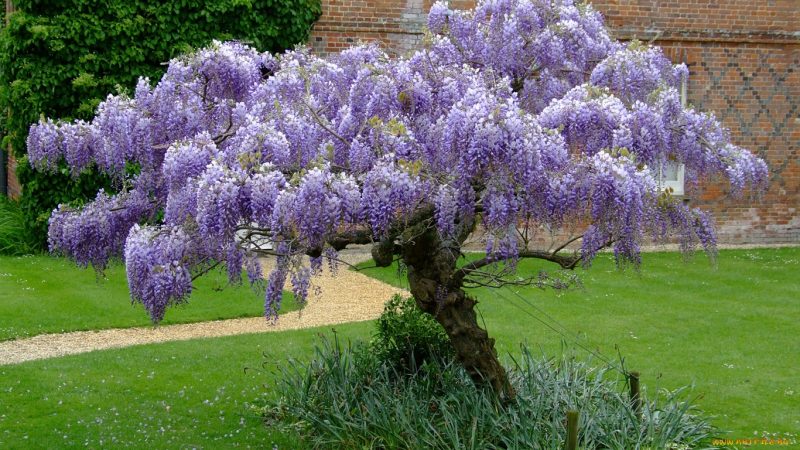
Chinese wisteria - liana - loves bright light, but will not die in the shade. As for the soil - it must be moist and fertile.
Regarding growing a house - such a large vine, of course, you will need regular pruning.
In outdoor conditions, wisteria can withstand temperatures up to -20 ° C, but such frosts should not be long, otherwise the plant will die.
Frost Resistant (Blue Moon)
This wisteria originates from the other side - in nature, it grows in North America.Its name in translation into Russian sounds beautiful - "Blue Moon". And it is much more suitable for growing in open ground in Russia.
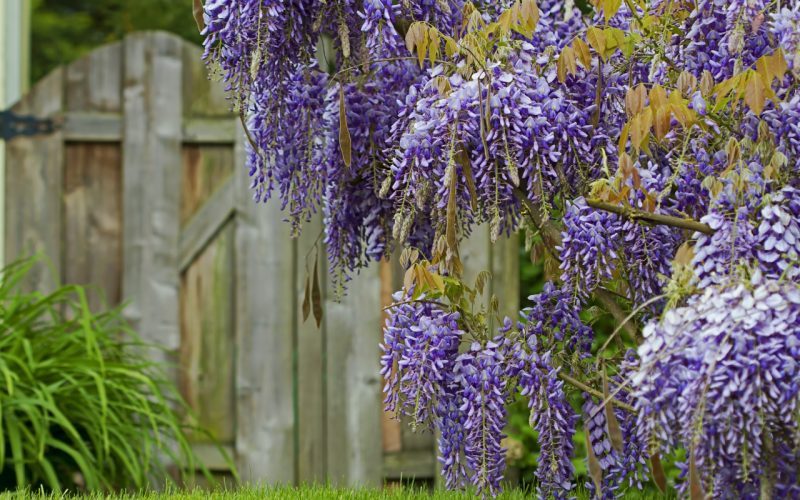
Wisteria blue moon can grow up to 8 m. It has dark green leaves, and the flowers are bluish or with a purple hue. Wisteria blooms in June, and its flowering lasts up to 3 weeks.
It will survive the Russian winter with success, as it is able to withstand frosts down to -40 ° C.
The plant prefers to grow on the south side of the site, where there is always enough sun, loves chernozem from the soil, and unlike Chinese wisteria, it does not require heavy watering.
Abundantly flowering or multi-flowering
And this luxurious wisteria comes from Japan. And although the size of the liana is not striking - up to 10 m, the leaves and flowers of this wisteria are impressive. Leaves - up to 40 cm, and inflorescences - up to 70 cm.
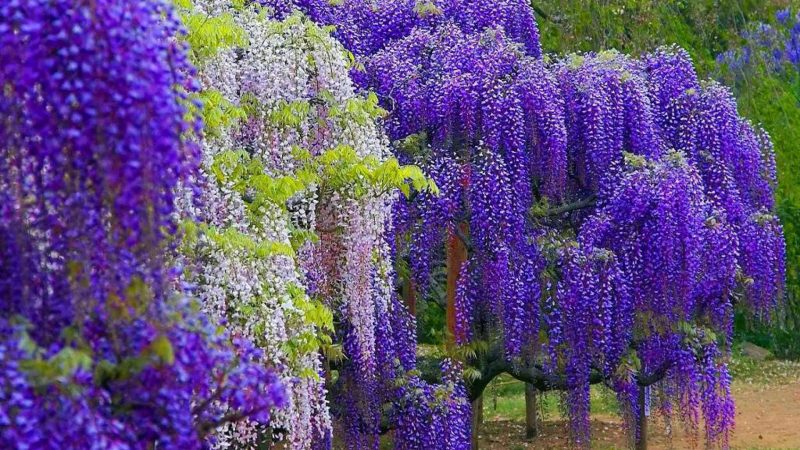
It may bloom at the end of May and, unlike other wisteria, the flowers will bloom gradually. The colors are different - white, reddish, purple.
It can grow in Russia, but the cold tolerates only up to -25 ° C. He loves fertile, well-drained soil.
Planting wisteria at home
Planting a wisteria at home is not so difficult. It is only important to follow certain rules.
Soil requirements
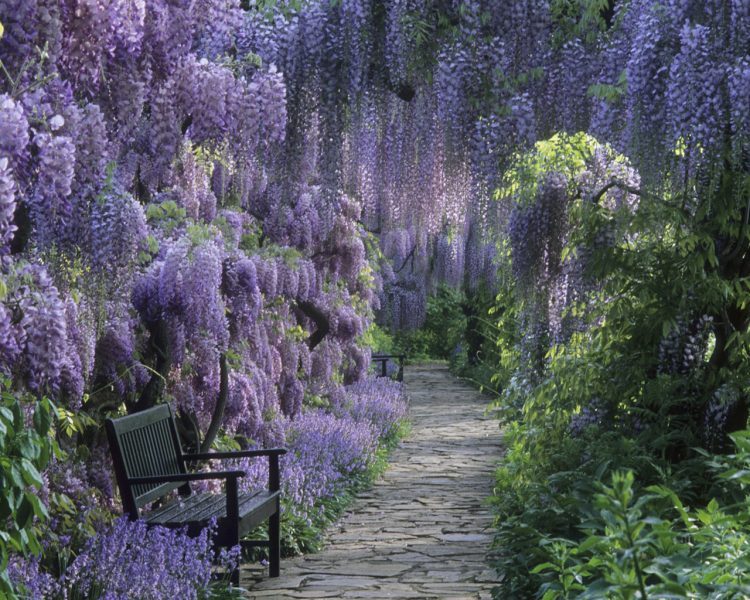
Wisteria prefers chernozem or loamy soils. It is especially important for her to there was no stagnation of water at the site. In some cases, in order to grow this spectacular plant, the place for planting is specially filled with fertile soil, and drainage is provided.
Location selection
At least 6 hours a day, a bright sunny color should fall on the wisteria. So you need to choose a place to land taking into account this condition. Given that blooming wisteria will definitely “fall” along the wall of the house, the plant is usually planted on the south or southeast side of the building.
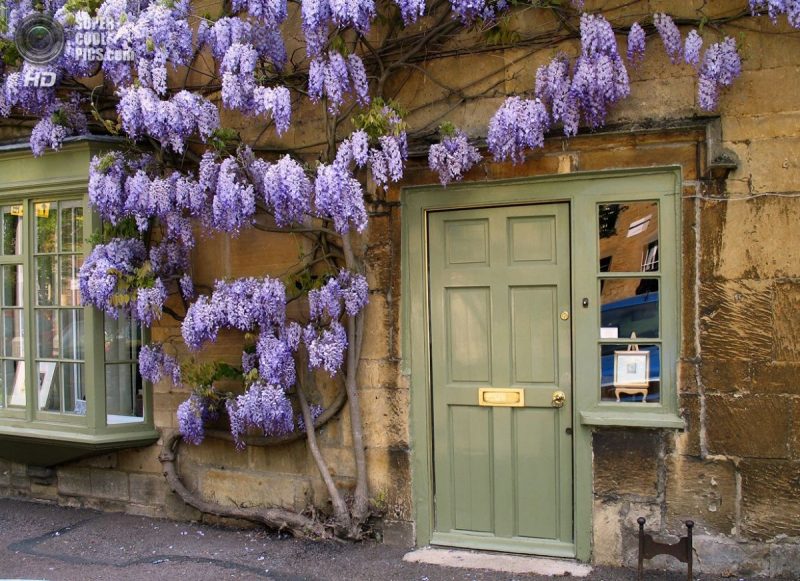
But at the same time, it is necessary that the wind does not interfere with the growth of wisteria, and that the plant has a sufficiently reliable support.
How and when to plant?
If most plants are traditionally planted in spring or autumn, then the planting time of wisteria depends on how you are going to propagate it.
Seeds are planted in December, in the greenhouse.
Cuttings root better in the spring. They can be planted both in a greenhouse and in open ground, if the soil is fertile enough, and it is already warm on the street.
Wisteria care at home
Wisteria care boils down to providing the plant with proper lighting, watering, and regular fertilizing.
Temperature and lighting
Wisteria, planted in the garden, easily adapts to Russian temperatures, excluding areas with very cold winters. The place you need to choose is well-lit, where vines are not threatened by drafts and strong winds.

Shoots for further successful growth must be tied up, and the plant itself must be provided with strong support.
It is interesting:yuka flower
Watering and feeding
The main requirement for watering is that it should be regular, but not excessive. That is, it is important that the earth at the roots of Wisteria is always moist, but the plant does not tolerate stagnation of water.
As for top dressing, in order for Wisteria to reach its maximum size, have bright foliage and bloom profusely, you need to make it throughout the warm season.

You can use compost, rotted manure, complex fertilizers.
In the spring, wisteria is fed 1 time in 7-10 days, alternating organic and mineral fertilizers.
The vine is responsive to the application of superphosphate, vermicompost, peat. It is recommended that you water the Wisteria with chalk water from time to time.
Pruning
This is a very important point in the care of wisteria. From how correctly trimmed, it will depend on how many flowers appear on the vine. Wisteria is cut 2 times a year according to a certain pattern.
During planting, secateurs cut off the main shoot of the plant, leaving up to 90 cm and a strong bud. The side shoots are cleaned.
In the summer of the 1st year, the upper shoot of the plant is tied vertically, and the lateral shoots are tied at an angle of 45 degrees.
In the winter of the 2nd year, the main stem is cut at a height of 80 cm, the side shoots are shortened by a third.
In the summer of the 2nd year, the main stem is tied to the support again vertically, and the lateral ones at an angle of 45 degrees.
The main stems of the lateral branches are tied, other branches are shortened, the shoots are removed.
Starting from the 3rd year, they do the same.
Winter Care Rules
In order for Wisteria to safely survive the winter, it must be prepared for the cold season.
Dry shoots are cut, dried flower brushes are removed. Liana is untied and her branches are laid around the trunk. After that they shelter for the winter. You can use special agrofibre, burlap or heavy kraft paper. Young plants try to insulate additionally - sprinkle with mulch, needles, leaves, even earth. It is undesirable to use a cellophane film so that the shoots do not rot.
Plant propagation
Wisteria can be propagated in several ways. If there is no nursery nearby, then the easiest option is to plant seeds.
They are planted in November-December, in a light and nutritious soil. The composition of the soil should include - sheet earth, turf, as well as sand - about 1/6 of the total volume. It must be remembered that building sand cannot be used for this purpose, only river sand.
Please note - the seeds are laid on the surface, and then sprinkled with a thin layer of sand. The soil should be sufficiently moist. The box is covered with a film on top.
It is advisable to keep the container or box in a dark place at room temperature, from time to time to water the ground.
Shoots appear after a month, but the plants are kept in the dark for another 2 weeks, and only then they are transferred to a lighted room.
With the advent of the first leaves, each young wisteria is planted in its pot. Gradually the plants are hardened - regularly airing the room or transferring the wisteria to the loggia and terrace.
Wisteria and layering can be propagated. In the spring, a young stalk is cut and put into a box with earth, dug up, only the top of the stem should be at the top. After a year, the young plant is transplanted to another place.
Another option is propagation by cuttings.
In autumn, a strong vine with buds is cut into cuttings. Until spring, they are stored in a cellar, in moist soil. In spring, cuttings can be immediately planted in the ground, covered with cans or plastic bottles from above.
Diseases and Pests
Since wisteria is toxic, pests rarely attack it. And yet it does happen. Beautiful green foliage can be ruined by caterpillars. With a small amount, they are collected manually, but if there are quite a few caterpillars, the wisteria is sprayed with biological products. Insecticides will help from aphids, and acaricides will save from a tick.
In general, wisteria is a healthy plant, diseases bypass it.
Features of growing wisteria
Russia is so large that in its various regions the cultivation of wisteria has its own characteristics.
In outskirts of Moscow
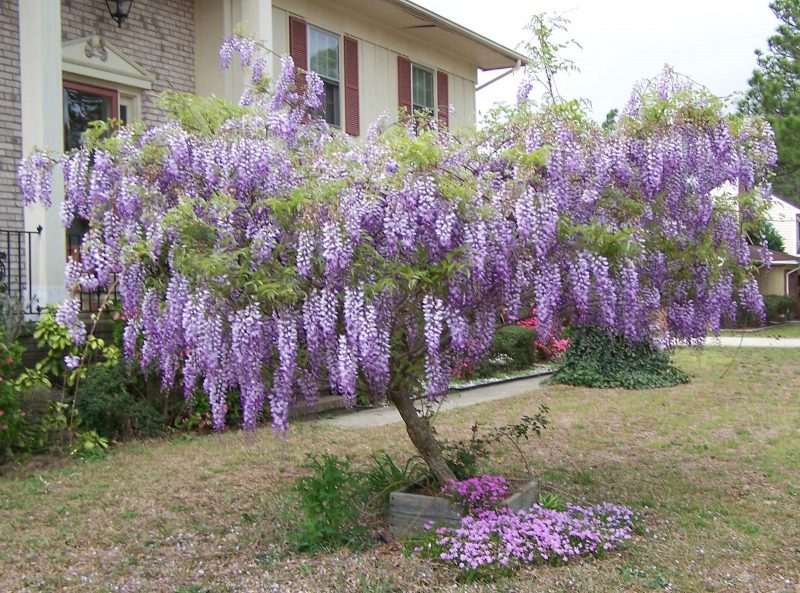
Everything is relatively simple here. You need to choose a sunny place, and when planting a plant, provide the roots with drainage. The depth of the holes should be 25-30 cm. In winter, the plant is covered.
In the Urals
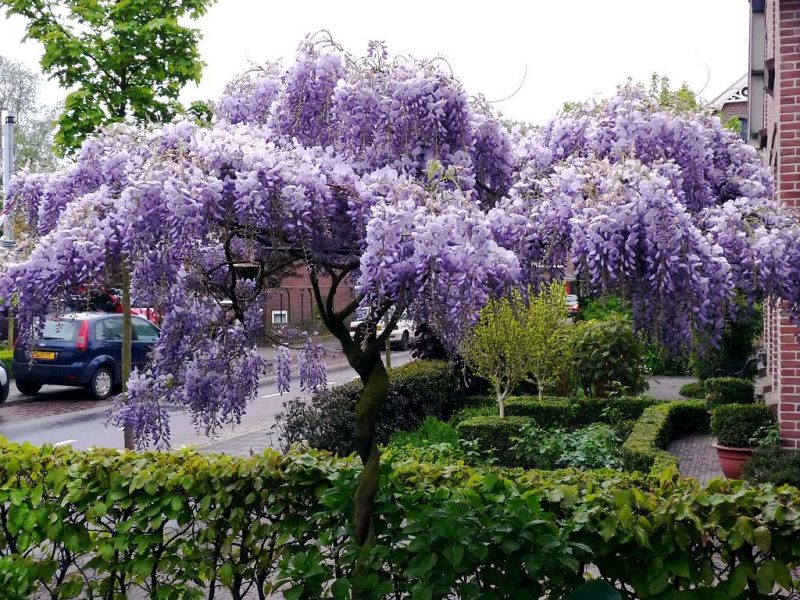
The Ural climate is colder. General wisteria care rules are retained. The plant is provided with slightly alkaline soil, regularly fertilized, protected from drafts. In winter, a layer of peat crumb is poured over the root system.
In Siberia
It must be borne in mind that gentle wisteria may not tolerate severe and prolonged frosts. In open ground, only the “Blue Moon” is worth growing here. A good option would be to plant wisteria in a large tub.
With the onset of warm pores, the plant can be taken out of the room onto the street.
In the middle lane
In the middle lane, wisteria is looked after in the same way as in the suburbs. It should be remembered that in some areas there are severe and prolonged frosts - given this, the shelter should be of high quality.
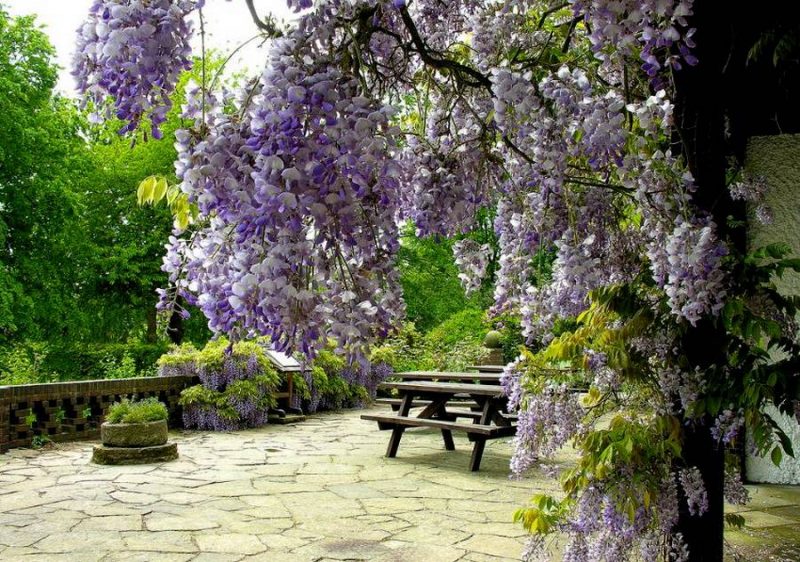
In addition, you need to pay attention to the composition of the soil. The sand mixture is enriched with fertilizers, the clay is “facilitated" by making humus, sawdust, and crushed bark.
Subject to all the rules of cultivation - wisteria will delight every year with its luxurious flowering.












